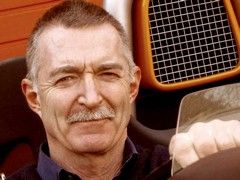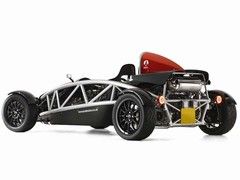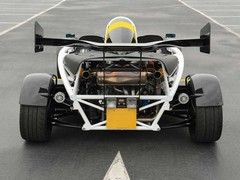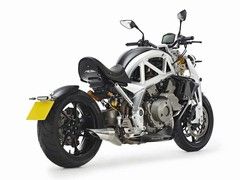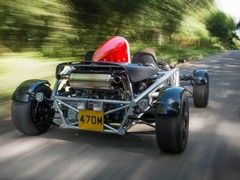Ariel's Simon Saunders: PH Meets
Ariel's founder on faster Atoms and why Microsoft Excel is the enemy of the small sports car industry

Despite which, Ariel is completely different to almost any other car company. And when you employ some rational business criteria it's almost as mad as the sort of start-ups that promise to beat Ferrari on power or Porsche around the Nurburgring.
"We're always flat-out," he says, in response to the opening question of how business is going. "We've just launched the new motorbike, so we've got to start making that at the beginning of next year, and there's a whole raft of work getting that into production. There are some more things in the pipeline too, we're beginning to employ more people. But we want to stay small, we don't want to keep growing and growing."
But isn't that what companies are meant to do? To get bigger and more profitable and diversify into other things?
Lean but not mean
"That's the accountant's view of how you should do it," Saunders admits. "You grow and grow and then sell the company and go and live in the Bahamas. But it's got no appeal to us whatsoever. We honestly don't have any aspirations to become a big company, the danger is what I call the TVR situation - you're not small enough to be small, you're not big enough to be big. It's the worst of both worlds. I've seen enough business plans in my life to see that people usually aim ludicrously high, and it's often a result of putting the numbers in to make the investment work. I really do blame Excel spreadsheets for this. If you've got to invest x million to get it up and running and you put in 50 or 100 cars a year and it doesn't work. Our aim, always, even before we started doing the Atom, was to sell 100 cars a year."
Which, uncoincidentally, is exactly what the company does - an annual total that's barely changed in the last decade. Each car is built up from its basic skeleton shell by one man, a process Saunders admits is deeply inefficient, but which both buyers and the company's workers like. And although the Atom has evolved constantly over the years - we're now on the 'third-and-a-half' generation - the fundamental recipe of minimal bodywork, a powerful engine and a complete lack of frippery hasn't changed at all.
Proper job
"The Atom always had to feel like a proper product," Saunders says, "there's not much on it, but what you do have is done well, beautifully built and reliable. We never wanted to make a rival for a Porsche or a Mazda MX-5, because we couldn't do that anyway, but also because we didn't want to build a car that would have a limited life, a five- or seven-year model cycle."
The Atom has got faster over the years. The limited edition V8 version - with its insane 500hp hand-built Hartley engine - was a big success, and the almost-as-rapid supercharged 3.5R is proving as popular with the brand's hardcore fans. So is the demand from existing owners and new customers always for faster versions?
"I think a lot of it is self inflicted, if I'm honest," Saunders says, "and it's partly your fault as well [we think he means journalists] - the new one needs to be better and that usually means it needs to be faster. And of course it's nice to win acceleration contests, 0-100s, that sort of thing... I think we're well along the law of diminishing returns, though - you have to spend a lot more time and a lot more money to make incremental improvements. It's a fine balance for us, it's not a racing car, but it is becoming an extraordinarily fast car."
Development is still continuing. Ariel recently made a titanium-tubed Atom (the same car that's now wearing Avon and Somerset police livery) which Saunders thinks is probably the biggest welded titanium structure ever produced and which is 40 per cent lighter than the steel chassis. There aren't plans for a production version - which would be punishingly expensive - but Ariel is committed to reducing weight and has even got some government research grants to help it do so. "Even to stand still you have to save weight," says Saunders. "Our new lights are much better, but they're heavier and the bracket is bigger, so somewhere you've got to take some weight out of the car just to stand still... My feeling is we've got to move with the times, even as a low-volume manufacturer. If we don't then in 20 years we're going to be making antiques, things will have moved on and left us behind."
Half the work?
The fact that every new Atom is a bespoke commission allows the company to vet its potential customers as well. "We're quite moral about these things," says Saunders, "we sometimes talk people out of superchargers for instance. We say if you're not sure, have the car without, get used to it and when you want it come back and we'll retrofit it for the same price. We're doing ourselves out of money, but we'd rather have somebody safe and enjoying themselves than put them into a car that's going to intimidate them. You have to respect an Atom like a high-powered motorbike."
Bringing us to Ariel's radical new direction. The announcement of the fully customisable Ace motorbike earlier this year came straight out of left-field, but it's a decision that makes more sense the longer you think about it, pre-Atom the Ariel brand was more associated with bikes than cars. And Saunders started his career as a designer working for motorbike companies. "Something with two wheels should be half as difficult as something with four wheels, shouldn't it?" he says. "The truth is it's about 10 times more complicated..."
Early response has been overwhelmingly positive and customers start getting theirs next year. But Saunders also says the Ace is a good indication of how the company will change in the future, potentially adding new models rather than trying to increase sales. And internal debate has started about what exactly that third model could be.
"We don't want to just build another lightweight sports car," says Saunders. "It's that traditionally British thing to do - make something and then make something else to compete with yourself. We could do something as left-field as a chauffeur driven limousine - tongue in cheek here - because it's very suitable for low-volume production, although it probably wouldn't have a zig zag frame around the outside. The idea is to make something that's suitable for our level of production and an interesting vehicle - if we can't do it really well we don't want to do it at all. We don't want to come up with something that's half-baked."
On past form, there's not much risk of that.
Gassing Station | General Gassing | Top of Page | What's New | My Stuff

